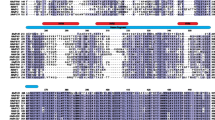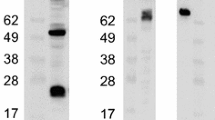Summary
Adenovirus type 7 vaccine strain was engineered to express foreign antigens from both the E 3 early promoter in the E 3 region and the major late promoter inserted between the E 4 region and the right inverted terminal repeat. This multiple expression vector was used to express hepatitis B core antigen (HBcAg), hepatits B e antigen (HBeAg), and hepatitis B surface antigen (HBsAg). The gene inserted in the E 3 region was derived from the core gene of the hepatitis B virus genome. When the precore region was present, an immunoreactive group of proteins with molecular weights ranging from 15,000 to 19,000 was secreted into the media. Velocity sedimentation centrifugation of media and lysates from cells infected with recombinants containing the core gene with the precore region resulted in peaks of HBeAg at the top of the gradient where authentic HBeAg should be found. In addition to the core gene in the E 3 region, the surface antigen gene of hepatitis B virus was inserted behind the major late promoter in the E 4 region resulting in an adeno-hepatitis recombinant virus capable of expressing both the core gene and the HBsAg cells. Cells infected with the adeno-hepatitis recombinants could also be stained with peroxidase-conjugates after reacting to antibody against HBcAg. Inoculation of dogs with the recombinant viruses which contained the core gene, with and without the precore sequence, resulted in a significant antibody response to HBcAg/HBeAg. The dogs also produced a significant antibody response to HBsAg as well as neutralizing antibody to adenovirus.
Similar content being viewed by others
References
Araki K, Miyazaki J, Hino N, Tomita N, Chisaka O, Matsubara K, Yamamura K (1989) Expression and replication of hepatitis B virus genome in transgenic mice. Proc Natl Acad Sci USA 86: 207–211
Berkner KL, Sharp PA (1983) Generation of adenovirus by transfection of plasmids. Nucleic Acids Res 11: 6003–6020
Bruss V, Gerlich WH (1988) Formation of transmembraneous hepatitis B e-antigen by cotranslational in vitro processing of the viral precore protein. Virology 163: 268–275
Burnette WN (1981) Western blotting: electrophoretic transfer of protein from sodium dodecyl sulfate — polyacrylamide gels to unmodified nitrocellulose and radiographic detection with antibodies and radioiodinated protein A. Anal Biochem 112: 195–203
Celis E, Ou D, Otvos Jr L (1988) Recognition of hepatitis B surface antigen by human T lymphocytes: proliferative and cytotoxic responses to a major antigenic determinant defined by synthetic peptides. J Immunol 140: 1808–1815
Cheng SM, Vogel R, Ye W, Blume M, Lee S, Hung P (1988) The core gene of hepatitis B virus; subtype adw2. Nucleic Acids Res 16: 8188
Clarke BE, Newton SE, Carroll AR, Francis MH, Appleyard G, Syred AD, Highfield PE, Rowlands DJ, Brown F (1987) Improved immunogenicity of a peptide epitope after fusion to hepatitis B core protein. Nature 330: 381–383
Colucci G, Beazer Y, Cataluppi C, Tackney C (1988) Identification of a major hepatitis B core antigen (HBcAg) determinant by using synthetic peptides and monoclonal antibodies. J Immunol 141: 4376–4380
Davis AR, Kostek B, Mason BB, Hsiao CL, Morin J, Dheer SK, Hung PP (1985) Expression of hepatitis B surface antigen with a recombinant adenovirus. Proc Natl Acad Sci USA 82: 7560–7564
Dewar RL, Natarajan V, Vasudevachari MB, Salzman NP (1989) Synthesis and processing of human immunodeficiency virus type 1 envelope proteins of human immunodeficiency virus type 1 envelope proteins encoded by a recombinant human adenovirus. J Virol 63: 129–136
Ferrari F, Chisari V, Ribera E, Penna A, Mondelli MU (1988) Functional modulation of hepatitis B core antigen-specific T-lymphocytes by an autoreactive T-cell clone. J Immunol 141: 1155–1160
Garcia PD, Ou J-C, Rutter WJ, Walter P (1988) Targeting of the hepatitis B virus precore protein of the endoplasmic reticulum membrane: after signal peptide cleavage translocation can be aborted and the product released into the cytoplasm. J Cell Biol 160: 1093–1104
Hanahan D, Gluzman Y (1984) Rescue of functional replication origins from embedded configurations in a plasmid carrying the adenovirus genome. Mol Cell Biol 4: 302–309
Hirt B (1967) Selective extraction of polyoma DNA from infected mouse cell cultures. J Mol Biol 26: 365–369
Iwarson S, Tabor E, Thomas HC, Gerety RJ (1985) Protection against hepatitis B virus infection by immunization with hepatitis B core antigen. Gastroenterology 88: 763–767
Jean-Jean O, Levrero M, Will H, Perricaudet M, Rossignol J (1989) Expression mechanism of the hepatitis B virus (HBV) gene. Virology 170: 99–106
Laemmli UK (1970) Cleavage of structural proteins during the assembly of the head of bacteriophage T 4. Nature 227: 680–685
Lieber M, Smith B, Szakal A, Nelson-Rees W, Todaro G (1976) A continuous tumor-cell line from a human lung carcinoma with properties of type II alveolar epithelial cells. Int J Cancer 17: 62–70
Logan J, Shenk T (1984) Adenovirus tripartite leader sequence enhances translation of mRNAs late after infection. Proc Natl Acad Sci USA 81: 3655–3659
Lubeck MD, Davis AR, Chengalvala M, Morin JE, Molnar-Kimber K, Natuk R, Mason BB, Mizutani S, Hung PP, Purcell RH (1989) Immunogenicity and efficacy testing in chimpanzees of an oral hepatitis B vaccine based upon live recombinant adenovirus. Proc Natl Acad Sci USA 86: 6763–6767
Mason BB, Davis AR, Bhat BM, Chengalvala M, Lubeck MD, Zandle G, Kostek B, Cholodofsky S, Dheer S, Molnar-Kimber K, Mizutani S, Hung PP (1990) Adenovirus vaccine vectors expressing hepatitis B surface antigen: importance of regulatory elements in the adenovirus major late intron. Virology 177: 452–461
Matsuda K, Ohori I (1988) Immunochemical characteristics of hepatitis B e antigen subspecificities, HBeAg/1 and HBeAg/2. J Immunol 141: 1709–1713
McLachlan A, Milich DR, Raney AK, Riggs RW, Hughes JL, Sorgi J, Chisari FV (1987) Expression of hepatitis B virus surface and core antigens: influences of pre-S and precore sequences. J Virol 61: 683–692
Milich DR, McNamara MK, McLachlan A, Thronton GB, Chisari FV (1985) Distinct H-2-linked regulation of T-cell responses to the pre-S and S regions of the same hepatitis B surface antigen polypeptide allows circumvention of nonresponsiveness to the S region. Proc Natl Acad Sci USA 82: 8168–8172
Milich DR, McLachlan A, Thornton GB, Hughes JL (1987) Antibody production of the nucleocapsid and envelope of the hepatitis B virus primed by a single synthetic T-cell site. Nature 329: 547–549
Milich DR, McLachlan A, Moriarty A, Thornton GB (1987) Immune response to hepatitis B virus core antigen (HBcAg): localization of T-cell recognition sites within HBcAg/HBeAg. J Immunol 139: 1223–1231
Milich DR (1988) T- and B-cell recognition of hepatitis B viral antigens. Immunol Today 9: 380–386
Miyanohara A, Imamura T, Araki M, Sugawara K, Ohtomo N, Matsubara K (1986) Expression of hepatitis B virus core antigen gene inSaccaromyces cerevisiae: synthesis of two poly-peptides translated from different initiation codons. J Virol 59: 176–180
Molnar-Kimber KL, Jarock-Witek V, Dheer SK, Vernon SK, Conley AJ, Davis AR, Hung PP (1988) Distinctive properties of hepatitis B virus envelope proteins. J Virol 62: 407–416
Morin JE, Lubeck MD, Barton JE, Conley AJ, Davis AR, Hung PP (1987) Recombinant adenovirus induces antibody response to hepatitis B surface antigen in hamsters. Proc Natl Acad Sci USA 84: 4626–4630
Murray K, Bruce SA, Wingfield P, Van Eerd P, De Reus A, Schellenkens H (1987) Protective immunization against hepatitis B with an internal antigen of the virus. J Med Virol 23: 101–107
Ohori H, Matsuda K (1989) Intra- and extracellular distribution and immunochemical characterization of hepatitis B virus nucleocapsid proteins produced by a human hepatoma cell line transfected with cloned viral DNA. Virology 168: 40–47
Ou J-H, Laub O, Retter WJ (1986) Hepatitis B virus gene function: the precore region targets the core antigen to cellular membranes and causes the secretion of the e antigen. Proc Natl Acad Sci USA 83: 1578–1582
Ou J-H, Bell KD (1990) Comparative studies of hepatitis B virus precore and core particles. Virology 174: 185–191
Prevec L, Schneider M, Rosenthal KL, Belbeck LW, Derbyshire JB, Graham FL (1989) Use of human adenovirus-based vectors for antigen expression in animals. J Gen Virol 70: 429–434
Rouse BJ, Norley S, Martin S (1988) Antiviral cytotoxic T lymphocyte induction and vaccination. Rev Infect Dis 10: 16–33
Salfeld J, Pfaff E, Noah N, Schaller H (1989) Antigenic determinants and functional domains in core antigen and e antigen from hepatitis B virus. J Virol 63: 798–808
Schneider M, Graham FL, Prevec L (1989) Expression of the glycoprotein of vesicular stomatitis virus by infectious adenovirus vectors. J Gen Virol 70: 417–427
Scolnick EA, McLean AA, West DJ, McAller WJ, Miller WJ, Buynak EB (1984) Clinical evaluation in healty adults of a hepatitis B vaccine made by recombinant DNA. JAMA 251: 2812–2815
Spessot R, Inchley K, Hupel TM, Bacchetti S (1989) Cloning of the herpes simplex virus ICP4 gene in an adenovirus vector: effects on adenovirus gene expression and replication. Virology 168: 378–387
Standring DN, Ou J-H, Rutter J (1986) Assembly of viral particles inXenopus oocytes: pre-surface-antigens regulate secretion of the hepatitis B viral surface envelope particle. Proc Natl Acad Sci USA 83: 9338–9342
Standring DN, Ou J-H, Masiarn FR, Butler WJ (1988) A signal peptide encoded within the precore region of hepatitis B virus directs the secretion of a heterogenous population of e antigens inXenopus oocytes. Proc Natl Acad Sci USA 85: 8405–8409
Suzuki K, Uchida T, Houicha R, Shikata T (1985) Localization of hepatitis B surface and core antigens in human hepatocellular carcinoma by immunoperoxidase methods. Cancer 56: 321–327
Tabor E, Gerety RJ (1984) Possible role of immune responses to hepatitis B core antigen in protection against hepatitis B infections. Lancet i: 172
Takehara K, Ireland D, Bishop DHL (1988) Co-expression of the hepatitis B surface and core antigens using bacculovirus multiple expression vectors. J Gen Virol 69: 2763–2777
Top FH Jr (1975) Control for adenovirus acute respiratory disease in U.S. army trainees. Yale J Biol Med 48: 185–195
Top FH Jr, Buescher EL, Bancroft WH, Russell PK (1971) Immunization with live types 7 and 4 adenovirus vaccine II antibody response disease due to adenovirus type 7. J Infect Dis 124: 155–160
Weiner J, Solfeld J, Will H (1987) Expression of the hepatitis B virus core gene in vitro and in vivo. J Virol 61: 3109–3113
Author information
Authors and Affiliations
Rights and permissions
About this article
Cite this article
Ye, W.W., Mason, B.B., Chengalvala, M. et al. Co-expression of hepatitis B virus antigens by a non-defective adenovirus vaccine vector. Archives of Virology 118, 11–27 (1991). https://doi.org/10.1007/BF01311300
Received:
Accepted:
Issue Date:
DOI: https://doi.org/10.1007/BF01311300




